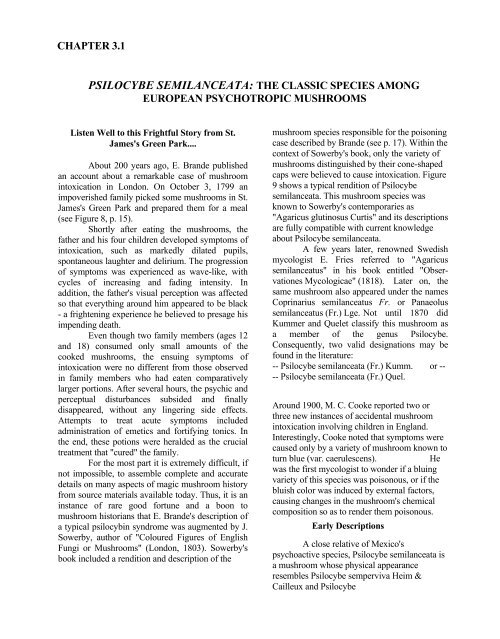Jochen Gartz - Magic Mushrooms Around the ... - preterhuman.net
Jochen Gartz - Magic Mushrooms Around the ... - preterhuman.net
Jochen Gartz - Magic Mushrooms Around the ... - preterhuman.net
Create successful ePaper yourself
Turn your PDF publications into a flip-book with our unique Google optimized e-Paper software.
CHAPTER 3.1<br />
PSILOCYBE SEMILANCEATA: THE CLASSIC SPECIES AMONG<br />
EUROPEAN PSYCHOTROPIC MUSHROOMS<br />
Listen Well to this Frightful Story from St.<br />
James's Green Park....<br />
About 200 years ago, E. Brande published<br />
an account about a remarkable case of mushroom<br />
intoxication in London. On October 3, 1799 an<br />
impoverished family picked some mushrooms in St.<br />
James's Green Park and prepared <strong>the</strong>m for a meal<br />
(see Figure 8, p. 15).<br />
Shortly after eating <strong>the</strong> mushrooms, <strong>the</strong><br />
fa<strong>the</strong>r and his four children developed symptoms of<br />
intoxication, such as markedly dilated pupils,<br />
spontaneous laughter and delirium. The progression<br />
of symptoms was experienced as wave-like, with<br />
cycles of increasing and fading intensity. In<br />
addition, <strong>the</strong> fa<strong>the</strong>r's visual perception was affected<br />
so that everything around him appeared to be black<br />
- a frightening experience he believed to presage his<br />
impending death.<br />
Even though two family members (ages 12<br />
and 18) consumed only small amounts of <strong>the</strong><br />
cooked mushrooms, <strong>the</strong> ensuing symptoms of<br />
intoxication were no different from those observed<br />
in family members who had eaten comparatively<br />
larger portions. After several hours, <strong>the</strong> psychic and<br />
perceptual disturbances subsided and finally<br />
disappeared, without any lingering side effects.<br />
Attempts to treat acute symptoms included<br />
administration of emetics and fortifying tonics. In<br />
<strong>the</strong> end, <strong>the</strong>se potions were heralded as <strong>the</strong> crucial<br />
treatment that "cured" <strong>the</strong> family.<br />
For <strong>the</strong> most part it is extremely difficult, if<br />
not impossible, to assemble complete and accurate<br />
details on many aspects of magic mushroom history<br />
from source materials available today. Thus, it is an<br />
instance of rare good fortune and a boon to<br />
mushroom historians that E. Brande's description of<br />
a typical psilocybin syndrome was augmented by J.<br />
Sowerby, author of "Coloured Figures of English<br />
Fungi or <strong>Mushrooms</strong>" (London, 1803). Sowerby's<br />
book included a rendition and description of <strong>the</strong><br />
mushroom species responsible for <strong>the</strong> poisoning<br />
case described by Brande (see p. 17). Within <strong>the</strong><br />
context of Sowerby's book, only <strong>the</strong> variety of<br />
mushrooms distinguished by <strong>the</strong>ir cone-shaped<br />
caps were believed to cause intoxication. Figure<br />
9 shows a typical rendition of Psilocybe<br />
semilanceata. This mushroom species was<br />
known to Sowerby's contemporaries as<br />
"Agaricus glutinosus Curtis" and its descriptions<br />
are fully compatible with current knowledge<br />
about Psilocybe semilanceata.<br />
A few years later, renowned Swedish<br />
mycologist E. Fries referred to "Agaricus<br />
semilanceatus" in his book entitled "Observationes<br />
Mycologicae" (1818). Later on, <strong>the</strong><br />
same mushroom also appeared under <strong>the</strong> names<br />
Coprinarius semilanceatus Fr. or Panaeolus<br />
semilanceatus (Fr.) Lge. Not until 1870 did<br />
Kummer and Quelet classify this mushroom as<br />
a member of <strong>the</strong> genus Psilocybe.<br />
Consequently, two valid designations may be<br />
found in <strong>the</strong> literature:<br />
-- Psilocybe semilanceata (Fr.) Kumm. or --<br />
-- Psilocybe semilanceata (Fr.) Quel.<br />
<strong>Around</strong> 1900, M. C. Cooke reported two or<br />
three new instances of accidental mushroom<br />
intoxication involving children in England.<br />
Interestingly, Cooke noted that symptoms were<br />
caused only by a variety of mushroom known to<br />
turn blue (var. caerulescens).<br />
He<br />
was <strong>the</strong> first mycologist to wonder if a bluing<br />
variety of this species was poisonous, or if <strong>the</strong><br />
bluish color was induced by external factors,<br />
causing changes in <strong>the</strong> mushroom's chemical<br />
composition so as to render <strong>the</strong>m poisonous.<br />
Early Descriptions<br />
A close relative of Mexico's<br />
psychoactive species, Psilocybe semilanceata is<br />
a mushroom whose physical appearance<br />
resembles Psilocybe semperviva Heim &<br />
Cailleux and Psilocybe








![The Big Lie 9-11 and Government Complicity in Mass Murder [PDF]](https://img.yumpu.com/50957077/1/190x245/the-big-lie-9-11-and-government-complicity-in-mass-murder-pdf.jpg?quality=85)








